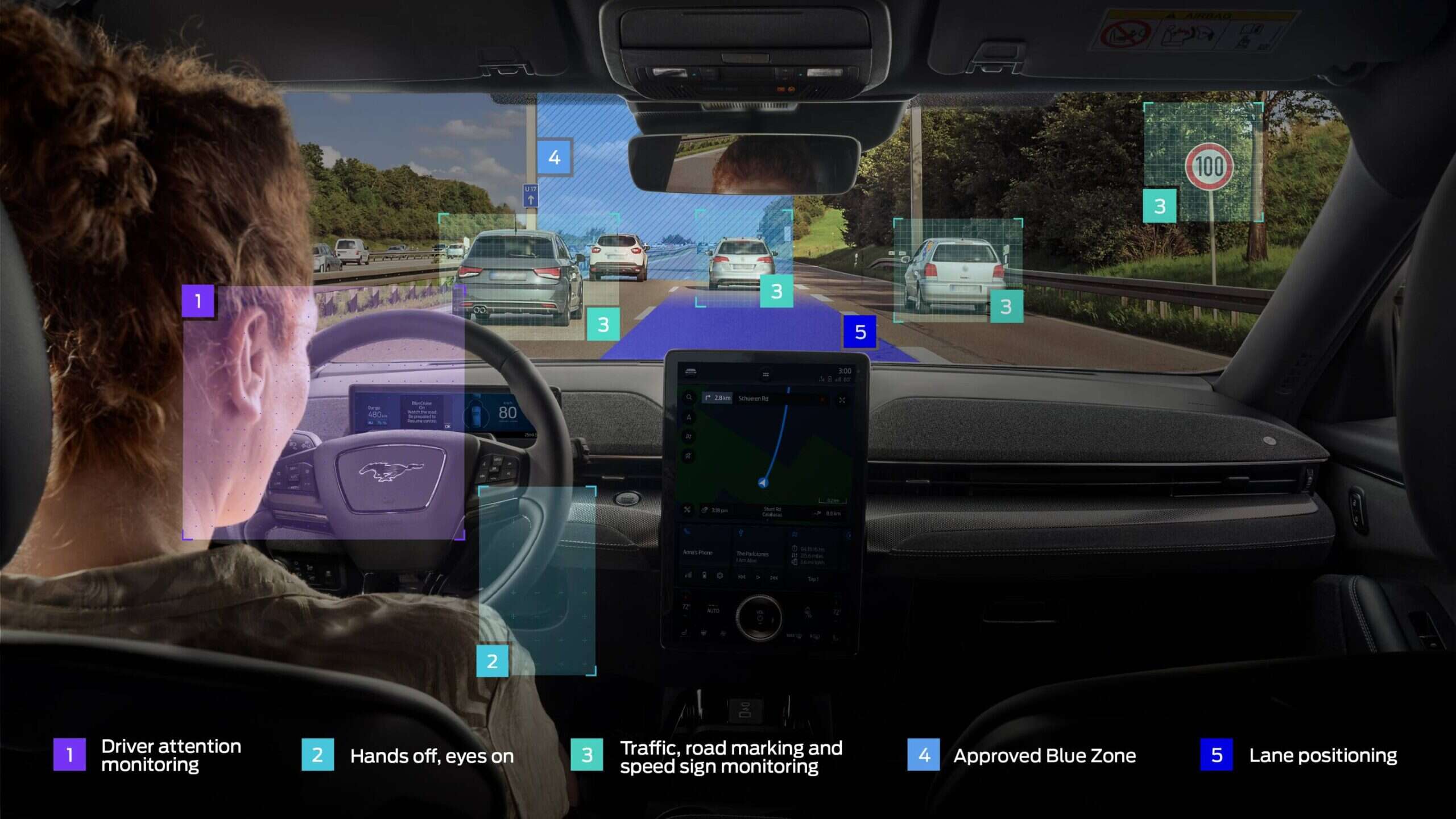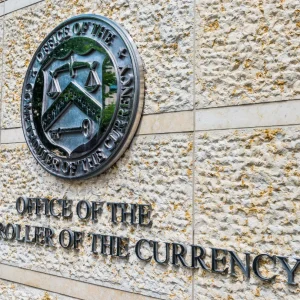
Ford has become the first automotive manufacturer in Europe to receive regulatory approval for its partial autonomous vehicle software, BlueCruise. It can now be used in 2023 Ford Mustang Mach-E SUVs on approved UK motorways.

BlueCruise is an SAE International Level 2 (Partial Driving Automation) hands-free advanced driver assistance system, described by Ford as a “hands-off, eyes-on” technology. The system monitors road markings, speed signs and evolving traffic conditions to control steering, acceleration, braking and lane positioning. It can also maintain safe and consistent distances to the vehicles ahead, including when cars are coming to a halt in traffic jams.
Using an infrared camera, the driver will also be continually checked by BlueCruise for their attentiveness to ensure safety for those in the driverless car and other road users. If the system detects driver inattention, warning messages will be displayed on the instrument cluster, followed by audible alerts, brake activations and finally slowing of the vehicle while maintaining steering control. It will also do this if the driver fails to put their hands back on the steering wheel when leaving a Blue Zone.
“Today marks a significant moment for our industry as Ford BlueCruise becomes the first hands-free driving system of its kind to receive approval for use in Great Britain,” said Lisa Brankin, managing director, Ford UK & Ireland. “We have always strived to make technology accessible for our customers and BlueCruise is this next step on this journey, making motorway driving a more comfortable experience.”
US powerhouse chooses UK for its European partial autonomous vehicle technology launch
Ford’s BlueCruise has only been available in the US and Canada. It has been used by more than 190,000 Ford and Lincoln drivers and their vehicles across over 60 million miles. It was also recently named a top-rated active driving assistance system in the US.
For its European launch, Ford engineers undertook 100,000 miles of testing on roads to validate its latest-generation advanced driver assistance systems including BlueCruise and its supporting features. Validation drives in Great Britain helped prove the software’s ability to handle circumstances drivers encounter every day, such as worn-out lane markings, poor weather and roadworks, according to the firm.
The UK government has made it clear that self-driving vehicles are one of its prime ambitions, backing the industry with £100m. In its cross-department report published in August 2022, ‘Connected & Automated Mobility 2025: Realising the benefits of self-driving vehicles in the UK’, its vision of connected and automated mobility was laid out, including rolling out self-driving vehicles by 2025.
It put aside £20m to help kick-start commercial self-driving services and enable businesses to grow and create jobs within the country. It also seemingly predicted that “self-driving features could be operating on motorways in the next year”.
Ford’s announcement also plays into the current narrative from the UK government about making the country an international technology superpower, reflected by Jesse Norman, UK transport minister as part of the announcement.
“It is great news that Ford has chosen Great Britain for the European launch of their BlueCruise technology, and I am delighted that this country is once more at the forefront of innovation,” Norman says. “The latest advanced driver assistance systems make driving smoother and easier, but they can also make roads safer by reducing scope for driver error.”
Experts continued to have ethical and safety concerns about autonomous vehicle technology
However, experts in the field of academia and legal are still weary of technologies such as BlueCruise and others that will follow.
Dr Catherine Menon, principal lecturer, department of computer science, University of Hertfordshire told Tech Monitor that not enough is being done to educate society about the “responsibilities when driving a BlueCruise-enabled car”. She has also flagged data privacy concerns due to the technology the software uses.
“BlueCruise is SAE Level 2, which means it’s solely there as a driver-assistance system; in other words, these are not self-driving cars,” she explained. Unfortunately[…] many media reports describe this as ‘self-driving technology’. It would be very easy for someone to buy one of these systems without fully understanding that the driver is still responsible for the entire driving task, and for keeping other road users safe.”
Ford describes its BlueCruise hands-free mode as allowing drivers to drive “with their hands off the steering wheel”. While they do caveat that drivers must continue to pay attention to the road ahead, Menon questions whether the technology places an “unacceptable burden” on the driver by requiring them to monitor the road and traffic without doing the physical driving themselves.
“It’s very difficult for a person to maintain the required degree of concentration when they’re not actually physically engaged in the task themselves,” she said. “The driver’s attention might wander, they might become distracted, and they’re very unlikely to have enough situational awareness about what’s going on around them to safely resume physically driving when they need.”
Menon says that BlueCriuse does mitigate against this by including an “eye-tracking camera” to alert drivers to any inattentiveness, but that there needs to be consideration whether maintaining focus is a realistic requirement for the average person.
Ben Pepper, a lawyer at Bolt Burdon Kemp, concurs with Menon, describing to Tech Monitor how complex it could get for automotive manufacturers if there are accidents in autonomous vehicles.
“Driverless technology is continuing apace but I fear the UK’s legislative framework isn’t quite ready,” he explains. “In August last year, the government unveiled a roadmap which included an indication that new laws for ‘the safe roll out of self-driving vehicles by 2025 will be brought forward when parliamentary time allows’. This isn’t happening quickly enough.”
Pepper also says that this new legislation could build on existing laws, meaning that manufacturers would be liable for accidents when the car is ‘self-driving’. This would mean that a human driver would not be liable for a crash or other accident.
“This could create some grey areas if someone is injured by a driverless car – it could be difficult to prove who was in control at the time of the accident and if the manufacturer was found to be liable, a claimant could find themselves bringing a claim under product liability law, rather than motor liability, and product liability legislation can be extremely complicated.”
Significant questions about data privacy and autonomous vehicles need to be asked
Menon also flags concerns she has with data privacy and BlueCruise’s eye-tracking technology and how the data might be recorded.
“Ford says that the data may be recorded in “crash-like” situations, which include near-misses as well as actual crashes,” Menon explains. “Because the recording device is a camera, data recorded might include your face, your actions, your gestures or possibly even whoever else is in your car if they’re visible. This type of stored data can be very vulnerable to malicious actors, because they can use it to build up a picture of who you are and what you’re doing.”
She also flags that the camera raises concerns around accessibility: “Ford confirms that [the technology] may not work well where the driver has a visible eye condition such as eye misalignment. This could risk these customers being incorrectly judged to be not looking at the road, for example. Clearly, an issue where legal liability is at stake.”






